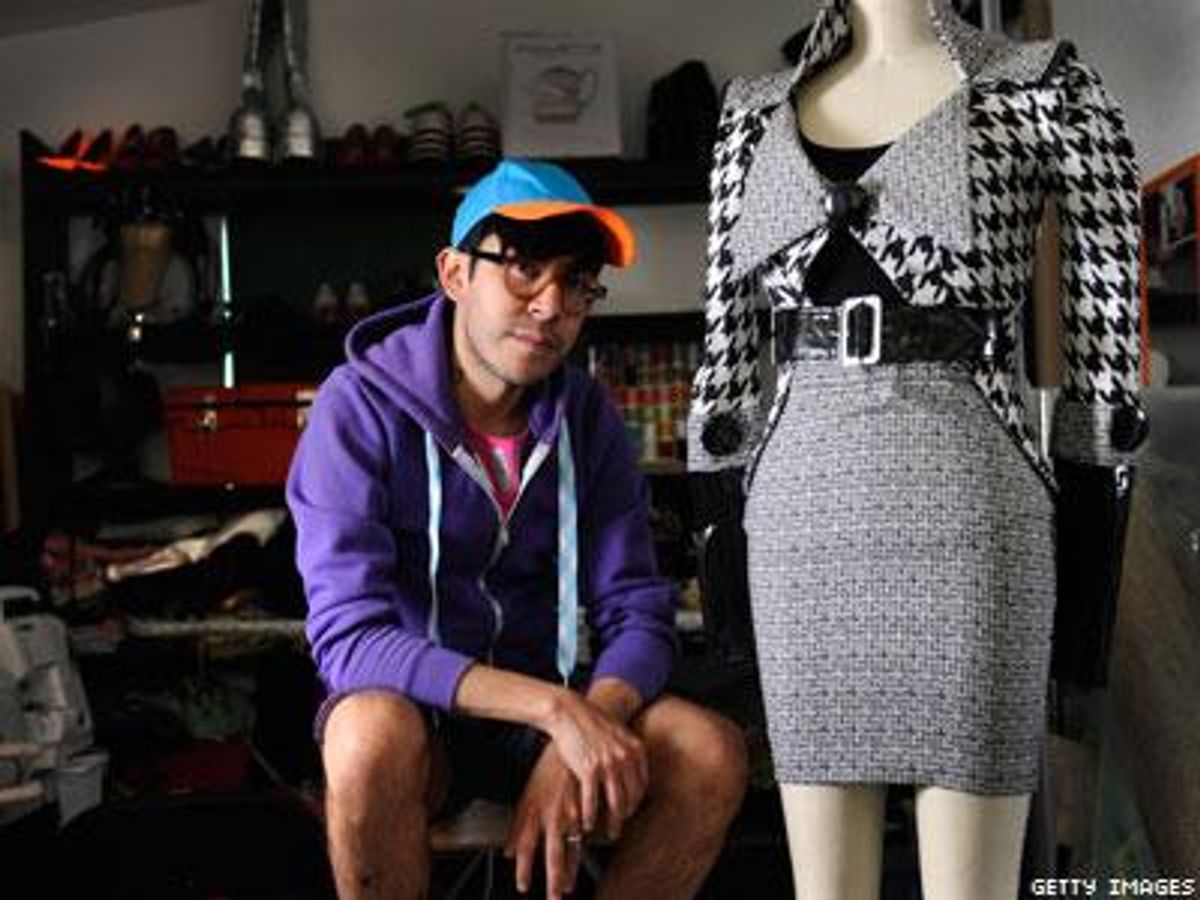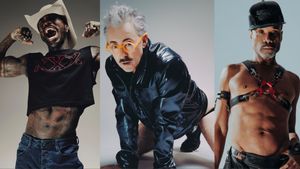When Mondo Guerra, the Project Runway star and fashion designer, was asked if he was “that guy” on television at a Denver bar last year, he normally would have bristled. But Guerra, who had sent the man a drink to attract his attention, sensed something special in their exchange.
“We really connected on an emotional level,” the 35-year-old designer admits with a smile.
And now, over a year later, Guerra chats happily about this evening’s romantic plans with that same guy, his boyfriend, Eduardo. He’s cooking up a special meal for Eduardo, less formally known as “the cutest boy ever.” The two recently returned from El Paso, Texas, where Guerra finally met Eduardo’s parents.
It’s not just tonight’s meal, though. The gourmand Guerra has had food on his mind for some time since he is an official celebrity spokesman for Dining Out for Life, a nationwide fundraiser in which more than 3,000 participating restaurants will donate a portion of all sales on April 24 to local HIV and AIDS charities.
“It’s the perfect opportunity to help out the community,” says Guerra, who lists French food as among his favorite cuisines, particularly the frisée salad, a savory mélange of lettuce, bacon, and poached eggs. “And you get to enjoy a good dinner. So why not?”
This is the second year that Guerra has participated in Dining Out for Life in an official capacity. He designed a limited edition “Movers and Shakers” T-shirt, printed with salt and pepper shakers, the proceeds of which will benefit the organization. He says the purpose of the shirt’s playful design as well as the event is to get people talking about HIV.

Mondo shows of the limited edition “Movers and Shakers” T-shirt he designed for Dining Out for Life (above)
“If you want to do something special and very unique one night of your year, it could be April 24,” Guerra says. “Make a reservation on DiningOutForLife.com and enjoy it with somebody that you think might not necessarily seek out the information on HIV. And take them to this restaurant and maybe surprise them. ‘This is what’s happening. This is why we’re here.’ It could be a wonderful conversation over a great dinner.”
More than many, Guerra knows the power of words to educate. After over 10 years of keeping his status a secret, Guerra came out as HIV-positive in 2010, on season 8 of Project Runway, in which he finished as first runner-up. Now the Mexican-American designer has become an HIV activist and public figure, most recently working with Merck on a national education campaign called I Design. In this capacity, he tours the country and speaks at universities about his life story.
“I always encourage the students to leave the auditorium and take somebody out to dinner and have this conversation and really talk about what you learned,” he says, “I always ask them to think about what the takeaway was from this conversation: ‘What inspired you today?’ And use that inspiration to continue that conversation with somebody that you think might not necessarily want to talk about it or might not have the opportunity to talk about it. So it’s really about passing on the information.”
For Guerra, these heart-to-heart talks are often important milestones in his life too. Shortly after coming out on Project Runway, the Denver native spoke with the show’s mentor, Tim Gunn, about his own experiences with HIV and AIDS. The 60-year-old Gunn, who is also gay, has previously said that he has been celibate for about 30 years due to a fear of contracting the virus.
“We had time off camera,” Guerra says. “He sat next to me and encouraged me and congratulated me for being able to talk about it. He shared his own personal stories of being affected by HIV and moving to New York in the ’80s when it was so prominent and scary. It was really wonderful to feel that Tim felt comfortable enough to share a little bit of himself.”

The designer acts as mentor on Under the Gunn, with Tim Gunn (above left) and other Project Runway alum
Guerra, who continues to collaborate with the older fashion guru as a mentor to designers on Lifetime’s Under the Gunn, says conversations such as these are particularly important among people from different generations who are affected by HIV.
“I feel like it is important to look forward, whether you’re 19 years old or if you’re 50 and you lived through it in the ’80s,” says Guerra, who sees stigma surrounding the virus as a substantial hurdle that still needs to be addressed. “There isn’t a cure yet.”
Guerra also served in the role of mentor to Viktor Luna, the designer who came out as HIV-positive on Project Runway All Stars in December. Luna had confided in Guerra just before the show’s taping, a conversation that Guerra believes may have helped Luna find the confidence to disclose his status on national television. From experience, he also attests to the supportive setting of the Project Runway workroom.
“It’s an encouraging and very supportive environment,” says Guerra. “Yes, we see all the drama that happens, and that is the television show. But being in the workroom and being around other exceptionally creative people that are doing what they love makes me feel very safe. It makes me feel very comfortable. And ultimately, I think that’s what gave me the strength to talk about it.
“I think that’s a good example of surrounding yourself with people that really inspire you and encourage you and support you to do your best work, whatever that is,” he adds.
His recent projects reflect his commitment to both cause and craft. In March he celebrated the launch of his fashion label, available at MondoGuerra.com, as well as a partnership with the shoe designer Crocs. He also recently released a line of ’70s-inspired eyewear through the optical store SEE, with proceeds that benefit the AIDS organization amfAR.
But Guerra is also thinking long-term. In 10 years he hopes to have established a foundation that instructs youth in the creative arts as well as HIV and AIDS awareness. Interacting with people, he says, is among the most gratifying aspects of his career.
“The most rewarding [experience] is being able to hear everybody’s story and really engaging in conversation with people who are affected by HIV—not necessarily infected, but affected,” Guerra says. “And when you think about it, I think everybody, whether they know it or not, is affected by HIV.”

















































































